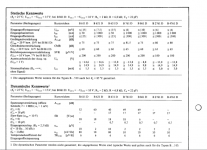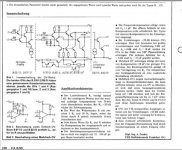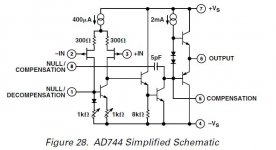OK This is what I have found, in my experience, how to make the best electronics possible, all else being equal.
1. Just using purely passive high quality parts is as good or better than almost any amplified electronics. (What I use in my office for a preamp)
2. IF you have to use electronic amplification, then use a minimum path, as linear as possible, zero global feedback, and a very high open loop bandwidth. (Blowtorch, Vendetta first stage)
3. If you MUST use global feedback, use as fast and as high open loop bandwidth as possible. This is important! Also make the circuits as linear as possible, within their marketing constraints. (JC-2, Vendetta second stage, Constellation second stage, JC-1 power amp, JC-3 power amp, JC-80 preamp)
4. IF you must use IC's, try for fast and video ready ones, IF POSSIBLE. If not, especially for extra low noise, use the best parts that you can find, and SUBJECTIVELY listen to each and every one type, and select what sounds best to you. (JC-3 phono preamp)
In every case, use the best passive parts, best power supply, capacitors, connectors, wires, etc that you find works for you, and usually, others in the field.
If you follow these suggestions, you will normally be ahead of the pack in making an audio quality product, be it for yourself, or for the general public.
Interesting someone sent me an article by Dick Burwen today, he feels about the direct opposite. FWIW you can go a long way in audio following your rules, sometimes we cross precision instrumentation with audio. Playing an LP is not the same as weighing something to 6 digits.
Well, Dick Burwen and I have differed for the last 38 years. So what? He is a good designer, but he used to think that 100 earlier op amps in series were impossible to detect. (true story)
If I understand his POV he feels that issues with the recording (issues with digital signals) frequency response out weigh the impact of the electronics. Hence pieces like the Cello Audio Palette.
Different strokes.
Different strokes.
I have a Cello Audio Palette. The big model. It can improve bad recordings tremendously but it also adds some noise and fog.
Hi,
Funny story.
Back at that small east german maker of studio electronics I worked at in the 80's we used to do bypass tests with various sets of components or complete cassettes. One bypass test used four or six of our transformers in series (connected for unity gain of course) and at least in our test setup, based on Schulze Studio Monitors, we felt we were unable to tell these four or six transformers reliably.
But we could tell the insertion of a single B761/TAA761 (a german Audio Op-Amp, quite interresting, open collector output, SE Class A output, input differential folded cascode somewhat similar to what JC does, 85dB OLG with around 10KHz OLG Bandwidth, externally compensated, actually, a quite good Audio Op-Amp for the times I would say)...
Ciao T
Well, Dick Burwen and I have differed for the last 38 years. So what? He is a good designer, but he used to think that 100 earlier op amps in series were impossible to detect. (true story)
Funny story.
Back at that small east german maker of studio electronics I worked at in the 80's we used to do bypass tests with various sets of components or complete cassettes. One bypass test used four or six of our transformers in series (connected for unity gain of course) and at least in our test setup, based on Schulze Studio Monitors, we felt we were unable to tell these four or six transformers reliably.
But we could tell the insertion of a single B761/TAA761 (a german Audio Op-Amp, quite interresting, open collector output, SE Class A output, input differential folded cascode somewhat similar to what JC does, 85dB OLG with around 10KHz OLG Bandwidth, externally compensated, actually, a quite good Audio Op-Amp for the times I would say)...
Ciao T
Last edited:
Dick Burwen taught Mark Levinson about quality parts, soldering, and wire. He worked for Mark as a consultant for 1 or 2 years before I did. After I was hired, we replaced virtually every op amp module with one of my own design, at Mark's insistence.
Later, when I was long gone and Levinson was effectively sold to HK, Mark commissioned Dick Burwen to make the equalizer, and it is perhaps one of the best equalizers ever made. The only unit that I have experience with that might be better is an early Sontec (sp) unit made in the mid-70's, and designed by George Massenburg.
Later, when I was long gone and Levinson was effectively sold to HK, Mark commissioned Dick Burwen to make the equalizer, and it is perhaps one of the best equalizers ever made. The only unit that I have experience with that might be better is an early Sontec (sp) unit made in the mid-70's, and designed by George Massenburg.
Thorsten, could you put up the schematic for the TAA761? I am having trouble finding it. I suspect that Studer used something like this with an output stage in 1973, for there A80 MK 1 master recorder.
B611D - operaèní zesilovaè, TTL výstup, datasheet
One can buy them on-line 🙂 🙂
http://www.denkl.cz/eshop/b-611-d-8788
One can buy them on-line 🙂 🙂
http://www.denkl.cz/eshop/b-611-d-8788
Last edited:
John,
Others beat me to posting the Info, as you can see, in some ways a quite interesting IC concept for an Audio Grade Op-Amp (compared to example to NE5534).
I personally would have liked a bit of emitter degeneration or even FET Inputs.
But as it stands these where not bad. Still, I designed a whole new channel Cassette replacing discrete circuits with these and it sounded bad...
When we mixed the old discrete Mike Pre's and such with tunable gyrators using these Op-Amp as semi-parametric tone control and used these OPA's as buffers for non-critical buses (FX, Monitor etc.) we got a good compromise between functionality required and sound quality though.
Ciao T
Thorsten, could you put up the schematic for the TAA761? I am having trouble finding it. I suspect that Studer used something like this with an output stage in 1973, for there A80 MK 1 master recorder.
Others beat me to posting the Info, as you can see, in some ways a quite interesting IC concept for an Audio Grade Op-Amp (compared to example to NE5534).
I personally would have liked a bit of emitter degeneration or even FET Inputs.
But as it stands these where not bad. Still, I designed a whole new channel Cassette replacing discrete circuits with these and it sounded bad...
When we mixed the old discrete Mike Pre's and such with tunable gyrators using these Op-Amp as semi-parametric tone control and used these OPA's as buffers for non-critical buses (FX, Monitor etc.) we got a good compromise between functionality required and sound quality though.
Ciao T
The schematic looks pretty marginal without an output stage added. Too little current available.
That works best for me too.
Unfortunately, for development purposes, this is not an efficient way to evaluate designs and components, I'd need years with my limited spare time..
Zinsula
thanks for the reply. We live in the same country so what about to get in touch, if you like we can have a phone call or meet us?
John,
To add an external output, I used to add diodes and a little extra resistor in series with the main load resistor (2k) and then BD139/BD140 complementary pair on heatsinks, you can run quite a bit of current that way.
But for many applications the 6mA or so peak output current where more than enough...
Ciao T
The schematic looks pretty marginal without an output stage added. Too little current available.
To add an external output, I used to add diodes and a little extra resistor in series with the main load resistor (2k) and then BD139/BD140 complementary pair on heatsinks, you can run quite a bit of current that way.
But for many applications the 6mA or so peak output current where more than enough...
Ciao T
The schematic looks pretty marginal without an output stage added. Too little current available.
The PNP in those days was BAD, thus the use of only one. If that's a lateral pnp there is a parasitic collector not shown and the ft would only be a couple of MHz. 🙁
Last edited:
The PNP in those days was BAD,
Definitely, in the monolithic ICs technology.
Definitely, in the monolithic ICs technology.
I was assuming these were early IC's. The AD744 allows an external pnp to be directly paralleled. I forgot about the decompensation feature (an extension of OLBW). John only complains about the noise of early bi-FETs, but not all circuits are preamps. There were not many IC's that could do 225kHz at G = 1000.
Attachments
Last edited:
Hi,
No Ostalgia.
The original Chip was a Thompson Semi Part anyway, not East German.
Ciao T
Nostalgia for "Ossie" times? 🙂😀
No Ostalgia.
The original Chip was a Thompson Semi Part anyway, not East German.
Ciao T
- Status
- Not open for further replies.
- Home
- Member Areas
- The Lounge
- John Curl's Blowtorch preamplifier part II


